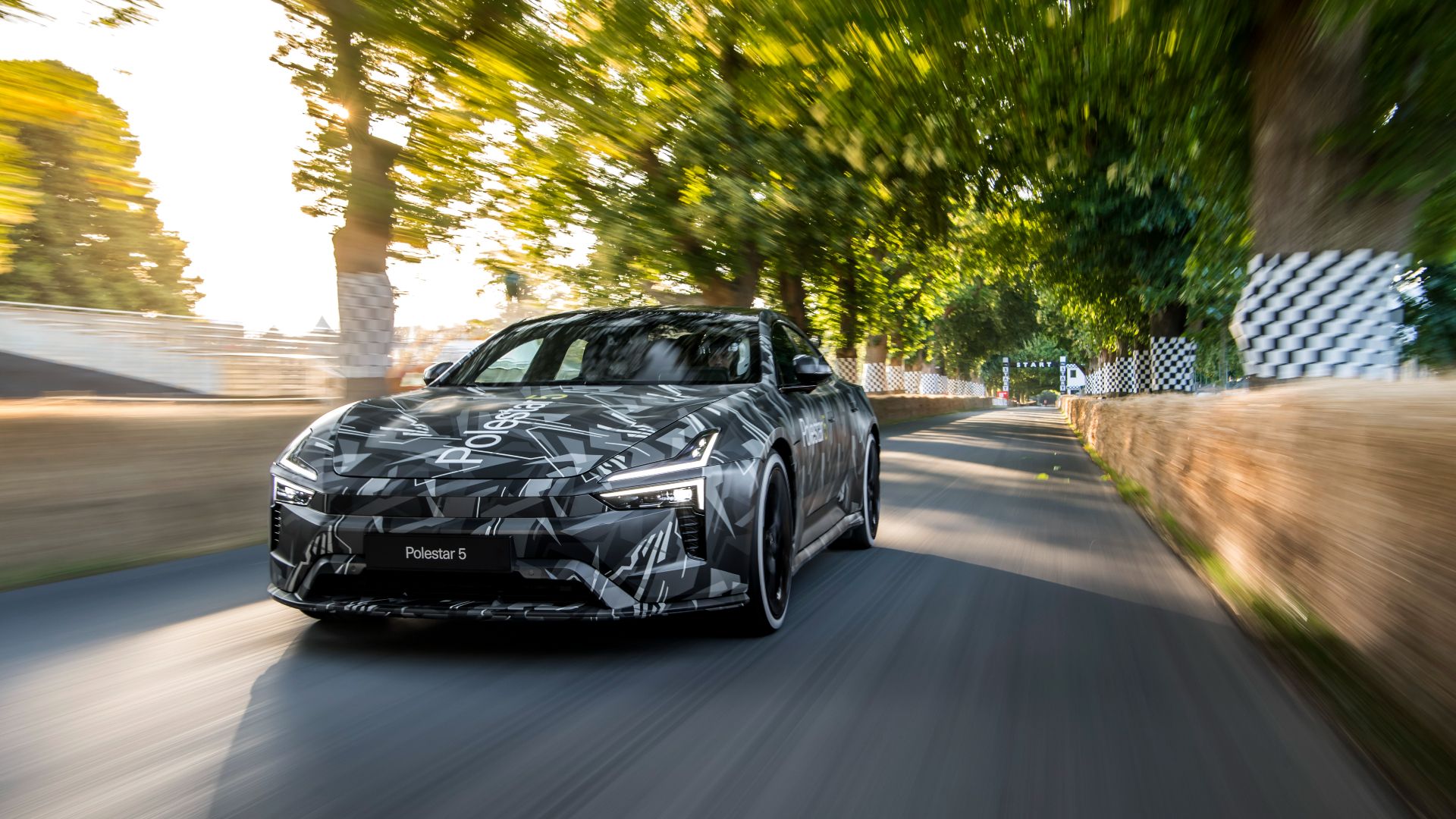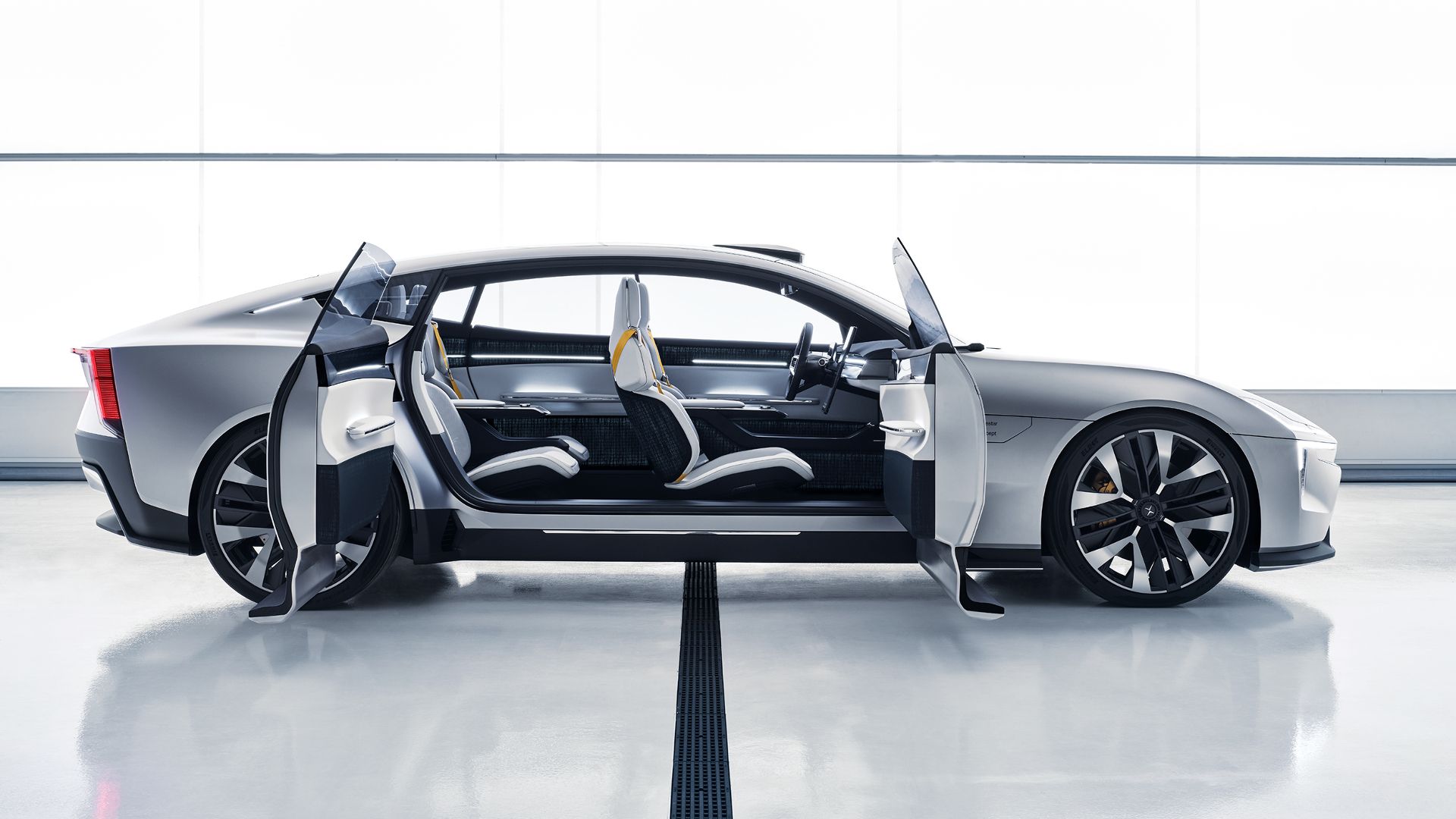Summary
- The Polestar 5 is an electric performance four-door GT that aims to change the status quo of the EV industry.
- The car features an 800 Volt architecture, dual electric motors, 884 horsepower, 663 pound-feet of torque, and an estimated range of 300 miles.
- Polestar's design philosophy focuses on creating a production car that is both innovative and practical, prioritizing safety, comfort, performance, and aerodynamics.
The Polestar 5 is an electric performance four-door GT nearing production. Its launch has been much anticipated, and just recently the most recent prototype made an appearance at the Goodwood Festival of Speed, held in West Sussex, England. More than being just another electric car, the Polestar 5 is looking to change the status quo of the EV industry. This futuristic four-door GT will be a competitive force in the battery electric vehicle (BEV) segment once it hits the market in 2024. Based on the Precept concept car, it has big shoes to fill and a mission to spearhead Polestar's future in the BEV segment.
Regarding the Precept, the Swedish automotive brand had this to say:
The automotive industry is facing pressing questions about design and environmental impact. Precept aims to answer these questions, showing our commitment to sustainable and engaging electric mobility.
The precept is undergoing a journey from a concept car to the Polestar 5. It's a long and challenging process that motivates Polestar's team of designers and engineers to continue to push the boundaries of what can be achieved when you set out to create a new BEV from the ground up, without even looking at the competition to draw inspiration from. And this design approach was completely intentional. Polestar's designers did not want to be influenced or contaminated by a bias of having to follow suit with what is already on the market.
All information regarding technical specifications and features of the Polestar 5 we are provided by the Polestar Company. Its development process has been documented and used as an inspiration to write this article.
Polestar 5 - The Concept
A concept car often works as a halo car for the developing team. They feature new ideas regarding design and technology and often give us a glimpse of the direction the company is moving toward. When Polestar's design team set out to work on a concept, they could shoot for the moon and really push the boundaries of what might be possible to bring into a production model. The Polestar 5 idea was born from the Precept concept car. Their goal was to create something that was innovative and exciting enough, and yet, at the same time, sufficiently grounded so as to not disappoint as a practical, everyday means of transportation.
One would be hard-pressed to consider the Polestar 5 a simple everyday commuter, however. The car features a new Polestar powertrain that features an 800 Volt architecture and produces a healthy amount of power and torque. With an estimated starting price of around $100,000, the Polestar 5 needs to really bring in the goods in order to grab a significant share of the segment.
Polestar 5 Performance Specs And Price
Powertrain | Dual electric motors |
Output | 884 horsepower |
Torque | 663 pound-feet |
Range | 300 miles |
MSRP | $100,000 (est.) |
Polestar set out to build a real car from the very beginning. They've walked a fine line between what would be a designer's dream, which might not be too practical for the real world, and what needed to be there physically so that people who interact with it won't feel alienated and disconnected from what was presented to them. A production car, after all, is made for the real world, and they have to be produced in with volume in mind, they have to be safe, and they have to deliver both comfort and performance. That is at the core of Polestar's design philosophy, and this is the car that is setting up the future of the brand, its design language, and technology for the upcoming years.
The Physical Manifestation
From the computer screens and renderings, Polestar's team built a real-size clay model of the car. The importance of the clay model in the development process of the car is that with it, you can quickly make changes if something doesn't quite work out in the physical world as originally intended. Unlike doing it in wood for instance, with clay you have a quick process to be able to change and see a completely different model if needed. Polestar finds this process So useful that they plan on having over 20 different clay models that will incorporate thousands of little adjustments before the design of the car is finally complete.
At the beginning of the design process, the exterior designer receives a brief from the head of design. This is what will guide and describe the overall style of the car. The Polestar 5 exterior design has a bold, sporty stance that exudes finesse and luxury. The design team tried to minimize the height of the car and create a look that packs everything together nicely. Requirements from other departments also influenced the design because the car needs to be able to work well as far as safety, comfort, performance, and practicality are concerned.
The exterior design has to be aerodynamic, for example. Aerodynamics is extremely important in electrical vehicles, especially when it comes to energy consumption. The aerodynamics team came in, doing their best to stay true to what was envisioned for the car while minimizing wind vortexes and other inefficient air flow areas around the body of the car, as this translates to a lot of wasted energy and impact the performance and range of the car. To that end, wind tunnel tests are done to study the effects of the wind on the car. After extensive testing in the wind tunnel, that particular team gathers data and provides feedback to the design and engineering team. With that hard data available, Polestar's designers and engineers can then decide on the cost-benefit analysis of changing the shape of the car even further, or not, in order to accommodate efficiency over aesthetics.
The Interior Design
One of the challenges to realizing the interior of a concept car into the interior of a production car is the fact that with a concept, designers are free from a lot of real-world limitations. They don't have to think about seat belt travel, knee room, moving seats, ducting, electronics, and other mundane aspects of an automobile. They get to express their creativity and design freely, within the boundaries of a certain brief. It falls to the engineers, while considering that wider spectrum of what was originally intended, to make things work as they should both inside and out of the vehicle.
The interior designers are tasked with proposing various ideas and concepts in order to make things fit in into the original design concept of the car. This is a very iterative process that has a lot of trial and error. It's a constant back-and-forth negotiation and cooperation between several areas of the company, though every design decision has to take into account technical and safety requirements.
The Swedish School of textiles in Boras, Sweden was tasked with finding the right materials for the interior of the Polestar 5. From this start, Polestar wanted to bring something new and innovative unlike anything else out there in the industry. The materials introduced in the Precept are being carried over to the Polestar 5, but not without a fair bit of challenge. Maria Uggla the color and material design manager at Polestar is captaining the effort of bringing these unique materials into the Polestar 5. They are using a new tailored knit technique to create upholstery, never before used in the automotive industry. The interior colors and materials are also connected, and influenced by, the car's overall design.
The Appearance At The Goodwood Festival Of Speed
In a bold move to showcase to the world what it has been cooking in Sweden, Polestar took a prototype to the Goodwood Festival of Speed where lots of eyes were checking out if the car measured up to what had been promised and expected from Polestar. There is always a risk involved in showing an early development vehicle to a lot of people in a less controllable setting. Mercedes, for instance, had a little mishap with the new AMG GT at the Goodwood Festival of Speed.
Polestar decided to do it anyway, precisely because of the risks. It's part of the excitement of the whole process, And luckily everything went really well. Being that this is not an event that is traditionally used as part of vehicle development, Polestar felt it had a unique opportunity to really test out how the car would behave in a myriad of different situations, be it on its famous hill climb, on corners or high-speed straights, and pretty much everything the road could throw at it. This allowed the engineers from the vehicle dynamics team to really work on the chassis of the Polestar 5. The steering, the suspension, the tires, and all other things concerned. There was a lot of excitement in the event but what's most important, there is also a lot of it in the product.



